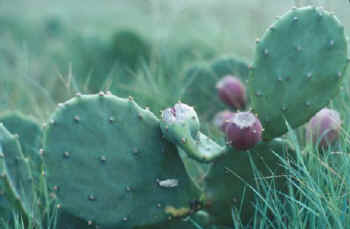|
The potential for an agent to be damaging will only be realised if the agent becomes sufficiently abundant. To effectively prioritise agents we must therefore be able to predict which agents, of those with most potential to damage, are going to become abundant. Obviously many individuals of an insect species which
'eats little' may be more effective than few individuals of an insect species which
'eats much'.
Theoretically the better adapted a biological control agent is to its new environment the more abundant it will become. Insects from similar climates and the same variety or subspecies of plant are thus given a higher priority, because they are more likely to be
pre-adapted to conditions in the new environment
(Harley and Forno
1992).
|

Young growth of Groundsel bush
(Baccharis halimifolia).
|
The computer program CLIMEX enables evaluation of climate similarity and dissimilarity between regions and so is a powerful tool in predicting whether potential agents are likely to be limited or favoured by climate. However, factors other than climate may be more significant in some cases
(See CLIMEX section). For example, a gall fly from the Californian Mediterranean-type climate introduced into climatically dissimilar south eastern
Queensland, with predominantly summer rainfall, to control
Baccharis halimifolia established well and initially became abundant. It now appears parasitism, not climatic dissimilarity, is limiting its abundance
(J. Melksham pers. comm. 1991).
There is some empirical evidence suggesting potential control agents from the same variety, subspecies or species of plant as the target weed are most likely to establish and become abundant. Recognising that the weedy salvinia in Australia and most other regions was different from the common species of
Salvinia in South America, and collecting potential control agents only from the species in South America which matched, were critical to the successful biological control of this water weed
(Harley and Forno
1992). Conversely,
Cactoblastis cactorum is native to South America but was spectacularly successful in Queensland against the north American prickly pear,
Opuntia stricta, which it had never encountered in South America.
|

Common pest pear (Opuntia inermis).
|
Five of seven insects introduced to control B. halimifolia collected from this same plant in north America were successfully reared and field released in southeast
Queensland. Only three of fourteen species from
Baccharis spp., not B. halimifolia, were ever successfully reared on
B. halimifolia (White and Donnelly
1993). However, of the five species that were successfully established from
B. halimifolia only one is now considered effective and one of the three established from other
Baccharis spp. is also considered effective (White and Donnelly
1993).
Insect species which have been introduced and become abundant in one region appear to have a high probability of becoming abundant in other regions
(Julien 1992).
Crytobagous salviniae has successfully controlled salvinia in tropical and subtropical Australia, Botswana, India, Papua New Guinea and South Africa.
Cactoblastis cactorum has successfully controlled Opuntia
stricta, Opuntia ficus-indica and Opuntia inermis where these cactus species occur in Australia, South Africa, Hawaii, New Caledonia and Nevis
(Julien 1992).
|

